Technical Regulations for Free Flight Contests
Class F1A – Gliders (Towline)
Class F1B – Model Aircraft with extensible motors (Wakefield)
Class F1C – Model Aircraft with piston motors
Class F1D – Indoor Model Aircraft
Class F1E – Gliders with automatic steering (HLG)
Provisional Events
Class F1G– Model Aircraft with Extensible Motors (Coupe D’Hiver)
Class F1H – Gliders (Towline)
Class F1J – Power Model Aircraft
Class F1K – Model Aircraft with CO2 Engines
Class F1L – Indoor EZB Model Aircraft
Class F1M – Indoor Beginner’s Class
Class F1N – Indoor Hand Launch Gliders
Class F1P – Power Model Aircraft
Characteristics of Gliders F1A
Surface area (St) ...................................................... 32 - 34 dm2 (496-527 in2)
Minimum weight ........................................................ 410 grams
Maximum length of launching cable loaded by 5 kg..... 50 m
3.5.2. Characteristics of Gliders with Automatic Steering F1E
Maximum surface area (St) ............... 150 dm2 (2,325 in2)
Maximum loading ............................. 100 g/dm2
Maximum flying weight ..................... 5 kg
Rule B.3.1. of Section 4b does not apply to class F1E.
F1E models may use radio control only for an irreversible action to restrict the flight, that is dethermalisation. Any malfunction or unintended operation of this function is entirely at the risk of the competitor.
3.H.2. Characteristics of Gliders F1H
Maximum Surface area (St) ......................................18 dm2 (279 in2)
Minimum weight ........................................................220 g
Maximum length of launch cable when loaded by 2 kg.50 m
3.K.2. Characteristics of F1K
Minimum weight (without CO2) .........75 g
Maximum surface area (St)..............12 dm2 (186 in2)
Maximum volume of the CO2 tank(s) 2 cm3 (connecting tubes count only if their outer diam. is over 2mm).

